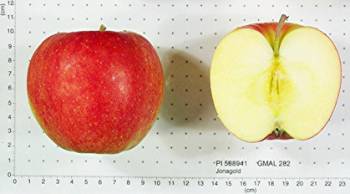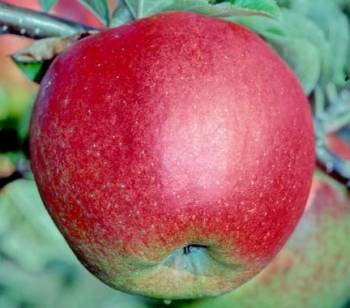PARENTAGE
The parents are the well-known Golden Delicious and the lesser well-known Jonathan which also originates from the USA.
APPEARANCE, TASTE AND CHARACTERISTICS OF JONAGOLD
Jonagold produces big apples there is no doubt about that! They also look the part with the side facing the sun a delicious shade of deep crimson red and the side in the shade being red streaks over a yellow to orange base. The tree itself it worthy of note being larger then the average apple tree and it looks solid and well-branched.
The blossom, although sterile, is particularly impressive as is the case with many other triploid varieties. Blossom appears in mid May normally with the fruits being ready for eating around mid-October.
The apples are not particularly regular in shape with the odd bulge or two but they are generally round. Taste is just about correct, sweetness backed up with some acidity – the taste quite clearly comes from the Jonathan parent.
For eating, the apples are at their peak when picked from the tree but they do keep well if picked just before they are ripe. They also perform well as a cooking apple retaining their shape for decorating flan toppings and open pies. The flesh is crisp and attractively white. There’s lots of juice in a Jonagold apple and they are top class for juicing or cider.

![]()
FLOWERING AND HARVEST TIMES OF JONAGOLD:
The average flowering time (optimum time for pollination) and date when fruits are ripe for harvest in the UK for the Jonagold apple tree are set out below. Jonagold is in pollination group 4. If you have set your home town we can give you a more accurate estimate, if you have not set your home town (do it now by clicking here) the dates below will be the average for the UK.
Your town has not been set, the average main flowering time for Jonagold
in the UK is the second week of May. Fruit will be ready for harvesting in the second week of October.
Click here if you want to set the dates to your home town.
Flowering and fruit picking dates vary according to the weather in any particular growing season so the above dates may well change slightly from one year to the next. The flowering date above is when the apple tree produces the maximum number of blossoms, it will also produce blossom, although less, a week or two either side of the date given.
BUYING A JONAGOLD APPLE TREE
Jonagold is not one of the common trees in the UK so you will be unlikely to find it at most garden centres although a few of the larger ones do stock them. Online these are not the most common tree to find but there are several stockist which can easily be found. Orange Pippin Trees stock them online and their page can be found here.
Remember that all apple trees need a stake to support them for the first couple of years and some require staking for life. So if you haven’t got a stake and a tie for your new tree then buy one when you order the tree for convenience.

![]()
JONAGOLD POLLINATION
We list below varieties which are suitable pollination partners for Jonagold which is in pollination group 4 and self-sterile (also a triploid).
- Arthur Turner – pollination group 3, self-sterile, cooker
- Bountiful – pollination group 3, self-sterile, cooker
- Braeburn – pollination group 4, self-fertile, eater
- Charles Ross – pollination group 3, partially self-fertile, cooker and eater
- Court of Wick – pollination group 3, self-sterile, eater and cooker
- Discovery – pollination group 3, self-sterile, eating and cider
- Dumelow’s Seedling – pollination group 4, self-sterile, cooker
- Ellison’s Orange – pollination group 4, partially self-fertile, eater
- Emneth Early – pollination group 3, partially self-fertile, cooker
- Epicure – pollination group 3, self-fertile, eater
- Falstaff – pollination group 3, self-fertile, eater
- Fiesta – pollination group 3, partially self-fertile, eater
- Gala – pollination group 4, partially self-fertile, eater
- Golden Delicious – pollination group 4, partially self-fertile, eater and cooker
- Granny Smith – pollination group 3, self-fertile, eater and cooker
- Grenadier – pollination group 3, partially self-fertile, cooker
- Honeycrisp – pollination group 4, self-sterile, eater
- Howgate Wonder – pollination group 3, partially self-fertile, cooker and eater
- James Grieve – pollination group 3, partially self-fertile, cooker and eater
- Katy – pollination group 3, self-sterile, both
- Kidds Orange Red – pollination group 3, self-sterile, eater
- King of The Pippins – pollination group 4, partially self-fertile, eater and cooker
- Lanes Prince Albert – pollination group 4, self-sterile, cooking
- Laxtons Fortune – pollination group 3, partially self-fertile, eater
- Laxtons Superb – pollination group 4, partially self-fertile, eater
- Lord Derby – pollination group 4, self-sterile, cooker
- Merton Beauty – pollination group 5, self-sterile, eater
- Newton Wonder – pollination group 4, partially self-fertile, cooker
- Peasgoods Nonsuch – pollination group 3, partially self-fertile, cooker
- Rajka – pollination group 4, self-sterile, eater
- Red Falstaff – pollination group 3, partially self-fertile, eater
- Scrumptious – pollination group 3, self-fertile, eater
- Sops in Wine – pollination group 3, self-sterile, juicer
- Spartan – pollination group 3, self-fertile, eater
- Sunset – pollination group 3, self-fertile, eater
- Tydemans Late Orange – pollination group 4, self-sterile, eater
- Waltz – pollination group 3, self-sterile, eater
- Winston – pollination group 4, self-fertile, eater
- Worcester Pearmain – pollination group 3, partially self-fertile, eater
The full list of apple tree varieties which we have reviewed is listed below. Select any one of them and then click the “More Information” button to be taken to the in depth review:

Rootstocks and Size
Guide to Planting
Care Plan
Pruning Apple Trees
Harvest and Storage
Pests and Disease
Pollination Groups
JONAGOLD APPLE TREE
Jonagold is a far more popular variety apple tree in the USA compared to the UK. The reason for this is not clear however it was developed at the Geneva Research Station in New York. Although bred in 1943 it was not released for public sale until 1950.
Jonagold is a triploid variety and is therefore self-sterile and cannot pollinate other apple trees. In common with many other triploid apple trees it is a vigorous grower and produces larger than normal apples. Although not particularly resistant to scab and mildew it can outgrow attacks from these diseases in most years.